我看过很多关于改变UILabel大小的例子。
这是我想做的事情: 更改字体大小,使文本在新高度内尽可能大。
有什么提示吗?
我看过很多关于改变UILabel大小的例子。
这是我想做的事情: 更改字体大小,使文本在新高度内尽可能大。
有什么提示吗?
我之前也遇到了同样的问题,通过这个帖子和Joel的算法,我解决了它。 :-)
以下是我用Swift编写的代码。我在iOS 8 + Autolayout中使用。
问题:
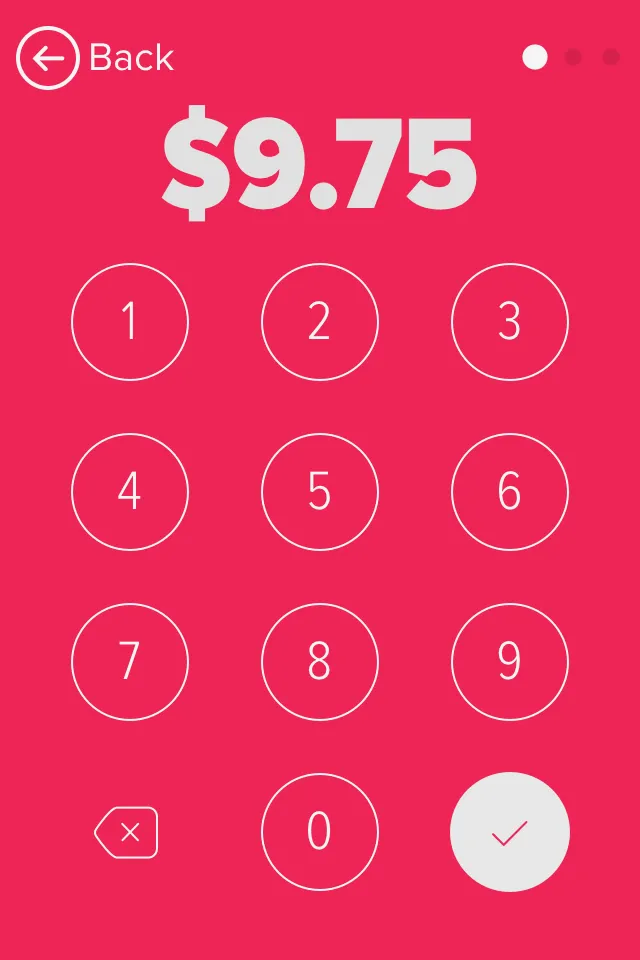
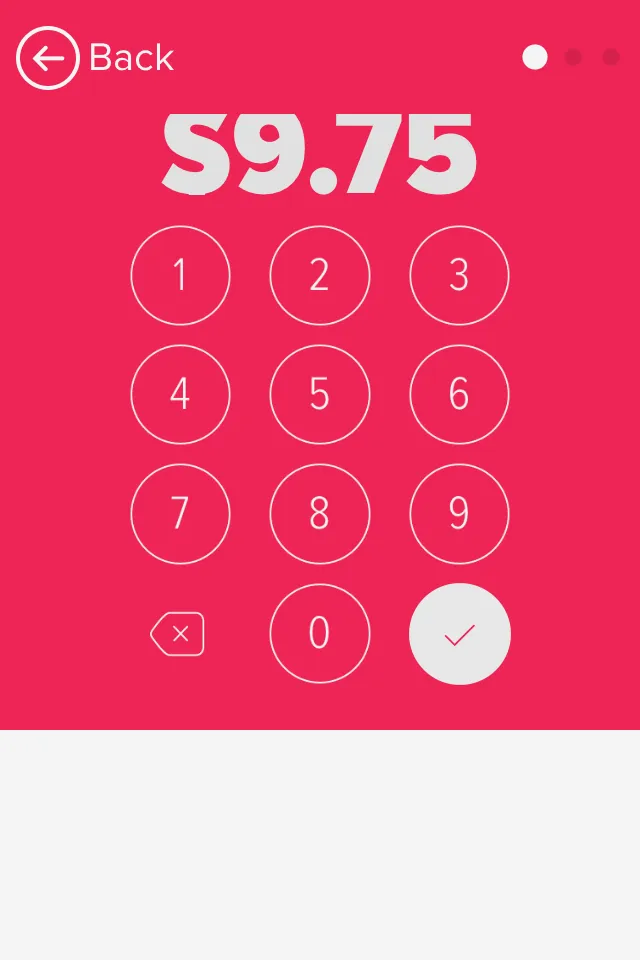
修复后:
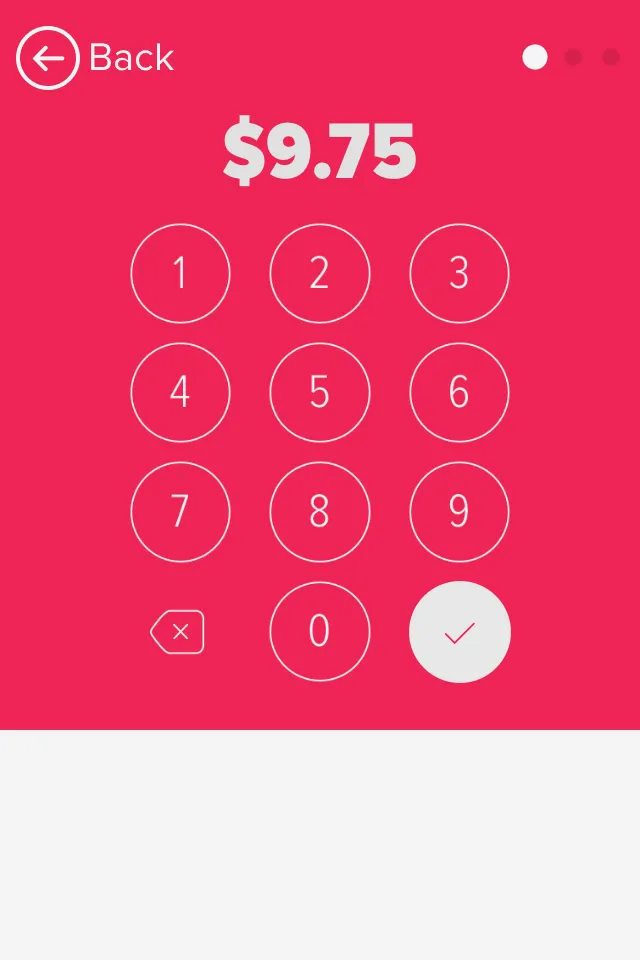
这正是设计师想要的... :)
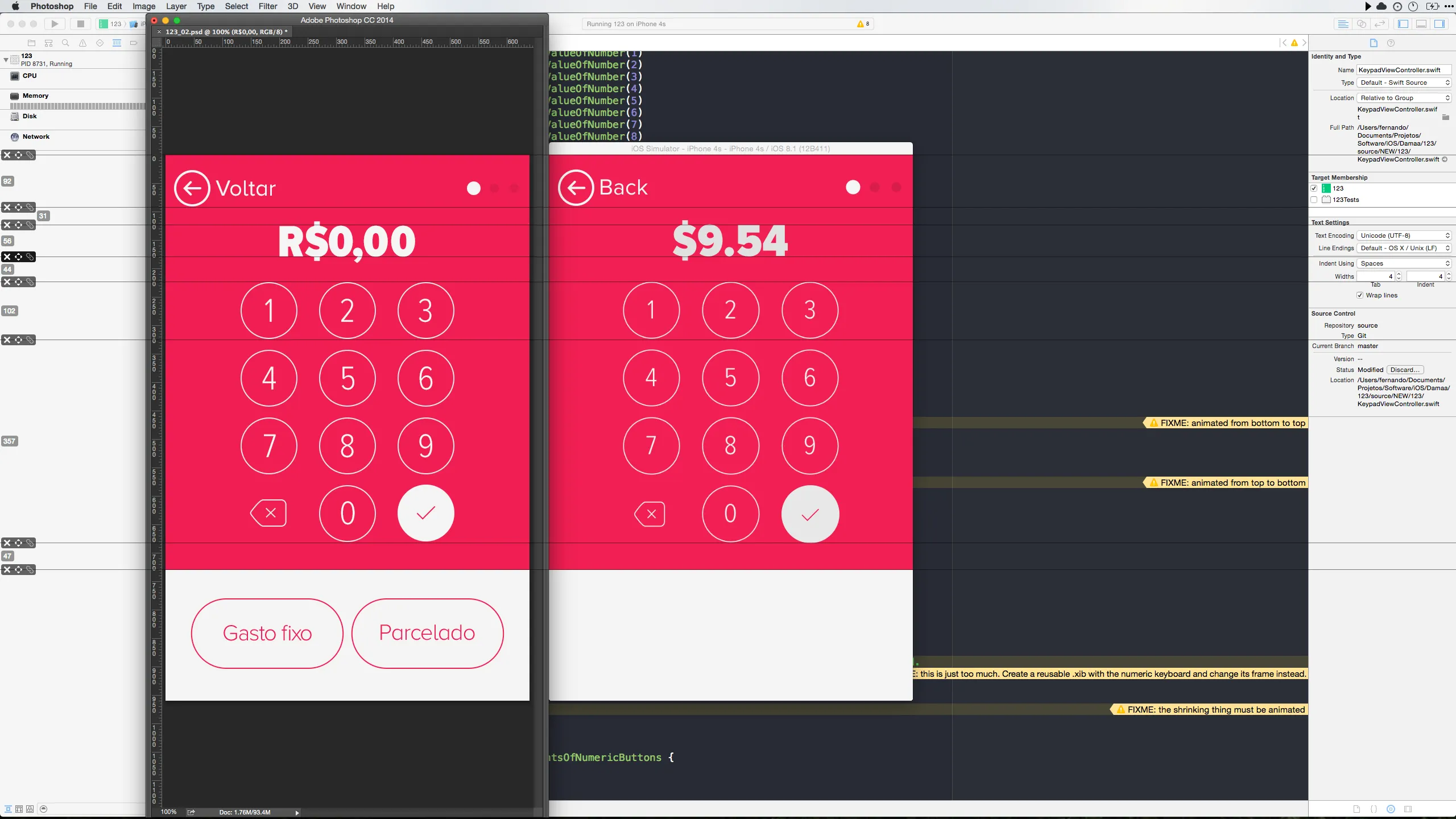
我创建了UILabel的子类,并覆盖了layoutSubviews方法。每次UILabel尺寸改变时,都会重新计算字体大小:
//
// LabelWithAdaptiveTextHeight.swift
// 123
//
// Created by https://github.com/backslash-f on 12/19/14.
//
/*
Designed with single-line UILabels in mind, this subclass 'resizes' the label's text (it changes the label's font size)
everytime its size (frame) is changed. This 'fits' the text to the new height, avoiding undesired text cropping.
Kudos to this Stack Overflow thread: bit.ly/setFontSizeToFillUILabelHeight
*/
import Foundation
import UIKit
class LabelWithAdaptiveTextHeight: UILabel {
override func layoutSubviews() {
super.layoutSubviews()
font = fontToFitHeight()
}
// Returns an UIFont that fits the new label's height.
private func fontToFitHeight() -> UIFont {
var minFontSize: CGFloat = DISPLAY_FONT_MINIMUM // CGFloat 18
var maxFontSize: CGFloat = DISPLAY_FONT_BIG // CGFloat 67
var fontSizeAverage: CGFloat = 0
var textAndLabelHeightDiff: CGFloat = 0
while (minFontSize <= maxFontSize) {
fontSizeAverage = minFontSize + (maxFontSize - minFontSize) / 2
// Abort if text happens to be nil
guard text?.characters.count > 0 else {
break
}
if let labelText: NSString = text {
let labelHeight = frame.size.height
let testStringHeight = labelText.sizeWithAttributes(
[NSFontAttributeName: font.fontWithSize(fontSizeAverage)]
).height
textAndLabelHeightDiff = labelHeight - testStringHeight
if (fontSizeAverage == minFontSize || fontSizeAverage == maxFontSize) {
if (textAndLabelHeightDiff < 0) {
return font.fontWithSize(fontSizeAverage - 1)
}
return font.fontWithSize(fontSizeAverage)
}
if (textAndLabelHeightDiff < 0) {
maxFontSize = fontSizeAverage - 1
} else if (textAndLabelHeightDiff > 0) {
minFontSize = fontSizeAverage + 1
} else {
return font.fontWithSize(fontSizeAverage)
}
}
}
return font.fontWithSize(fontSizeAverage)
}
}
有一个更简单的解决方案。只需添加以下几行代码,标签的字体大小就会神奇地调整以适合标签的高度:
SWIFT 3:
label.minimumScaleFactor = 0.1 //or whatever suits your need
label.adjustsFontSizeToFitWidth = true
label.lineBreakMode = .byClipping
label.numberOfLines = 0
以下是我的做法,因为 DGund 的回答对我不起作用,它适应了宽度,但我想让它适应高度。
+ (UIFont *)findAdaptiveFontWithName:(NSString *)fontName forUILabelSize:(CGSize)labelSize withMinimumSize:(NSInteger)minSize
{
UIFont *tempFont = nil;
NSString *testString = @"abcdefghijklmnopqrstuvwxyzABCDEFGHIJKLMNOPQRSTUVWXYZ";
NSInteger tempMin = minSize;
NSInteger tempMax = 256;
NSInteger mid = 0;
NSInteger difference = 0;
while (tempMin <= tempMax) {
mid = tempMin + (tempMax - tempMin) / 2;
tempFont = [UIFont fontWithName:fontName size:mid];
difference = labelSize.height - [testString sizeWithFont:tempFont].height;
if (mid == tempMin || mid == tempMax) {
if (difference < 0) {
return [UIFont fontWithName:fontName size:(mid - 1)];
}
return [UIFont fontWithName:fontName size:mid];
}
if (difference < 0) {
tempMax = mid - 1;
} else if (difference > 0) {
tempMin = mid + 1;
} else {
return [UIFont fontWithName:fontName size:mid];
}
}
return [UIFont fontWithName:fontName size:mid];
}
这将需要一个字体名称,一个大小(理论上它不一定是UILabel,但我总是与UILabel一起使用),以及一个最小大小(您也可以使用最大大小,只需将256替换为最大尺寸参数)。它将在最小和最大字体大小之间测试每个字体大小,并返回高度等于或略小于目标高度的字体大小。
用法很简单,看起来像这样:
self.myLabel.font = [self findAdaptiveFontWithName:@"HelveticaNeue-UltraLight" forUILabelSize:self.myLabel.frame.size withMinimumSize:30];
你还可以将这个方法作为 UIFont 的类方法类别(这正是我所做的)。
编辑:经建议,我移除了 for 循环并花了一点时间用二分查找算法使其更加高效。我进行了几项检查以确保字体最终适合标签内。初步测试表明它有效。
编辑:查看Joel Fischer的绝佳答案,以编程方式获取正确的大小!
您可以将字体设置为自动填充标签大小,并选择不低于最小字体大小。只需将adjustsFontSizeToFitWidth设置为YES即可。如果需要更多信息,请查看UILabel类参考文档。
虽然布尔值称为“adjustsFontSizeToFitWidth”,但它实际上意味着标签高度上保持单行(或者您指定的任意行数)的最大字体大小。
我已经根据我的标签高度调整了文本,我已经将Joel的方法转换为Swift
func optimisedfindAdaptiveFontWithName(fontName:String, label:UILabel!, minSize:CGFloat,maxSize:CGFloat) -> UIFont!
{
var tempFont:UIFont
var tempHeight:CGFloat
var tempMax:CGFloat = maxSize
var tempMin:CGFloat = minSize
while (ceil(tempMin) != ceil(tempMax)){
let testedSize = (tempMax + tempMin) / 2
tempFont = UIFont(name:fontName, size:testedSize)
let attributedString = NSAttributedString(string: label.text!, attributes: [NSFontAttributeName : tempFont])
let textFrame = attributedString.boundingRectWithSize(CGSize(width: label.bounds.size.width, height: CGFloat.max), options: NSStringDrawingOptions.UsesLineFragmentOrigin , context: nil)
let difference = label.frame.height - textFrame.height
println("\(tempMin)-\(tempMax) - tested : \(testedSize) --> difference : \(difference)")
if(difference > 0){
tempMin = testedSize
}else{
tempMax = testedSize
}
}
//returning the size -1 (to have enought space right and left)
return UIFont(name: fontName, size: tempMin - 1)
}
而我是这样使用它的:
myLabel.font = optimisedfindAdaptiveFontWithName("Helvetica", label: myLabel, minSize: 10, maxSize: 38)
println("\(myLabel.font)")
var tempHeight:CGFloat 不是必需的。 - S1UUIFont扩展,没有进行更改,代码如aLabel.font.optimisedfindAdaptiveFontWithName(".SFUIText-Regular", label: fontLabel, minSize: 10, maxSize: 100)。问题出在哪里? - S1U好消息,
您只需要使用比率搜索迭代(几次)即可。
guess = guess * ( desiredHeight / guessHeight )
// the call fontToFitHeight FINDS THE POINT SIZE TO "FILL TO HEIGHT".
// Just use autolayout to make the frame THE ACTUAL HEIGHT
// you want the type ON ANY DEVICE
// ADDITIONALLY you can set:
// the tracking (that's the overall amount of space between all letters)
// and streching (actually squeeze or stretch the letters horizontally)
// Note: tracking and stretching IS SHOWN IN STORYBOARD LIVE
// WTT crazyrems http://stackoverflow.com/a/37300130/294884
import UIKit
@IBDesignable
class StyledLabel: UILabel
{
@IBInspectable var tracking:CGFloat = 0.8
// values between about 0.7 to 1.3. one means normal.
@IBInspectable var stretching:CGFloat = -0.1
// values between about -.5 to .5. zero means normal.
override func awakeFromNib()
{
tweak()
}
override func prepareForInterfaceBuilder()
{
tweak()
}
override func layoutSubviews()
{
super.layoutSubviews()
font = fontToFitHeight()
}
private func fontToFitHeight() -> UIFont
{
/* Apple have failed to include a basic thing needed in handling text: fitting the text to the height. Here's the simplest and fastest way to do that:
guess = guess * ( desiredHeight / guessHeight )
That's really all there is to it. The rest of the code in this routine is safeguards. Further, the routine iterates a couple of times, which is harmless, to take care of any theoretical bizarre nonlinear sizing issues with strange typefaces. */
guard text?.characters.count > 0 else { return font }
let desiredHeight:CGFloat = frame.size.height
guard desiredHeight>1 else { return font }
var guess:CGFloat
var guessHeight:CGFloat
print("searching for... ", desiredHeight)
guess = font.pointSize
if (guess>1&&guess<1000) { guess = 50 }
guessHeight = sizeIf(guess)
if (guessHeight==desiredHeight)
{
print("fluke, exact match within float math limits, up front")
return font.fontWithSize(guess)
}
var iterations:Int = 4
/* It is incredibly unlikely you would need more than four iterations, "two" would rarely be needed. You could imagine some very strange glyph handling where the relationship is non-linear (or something weird): That is the only theoretical reason you'd ever need more than one or two iterations. Note that when you watch the output of the iterations, you'll sometimes/often see same or identical values for the result: this is correct and expected in a float iteration. */
while(iterations>0)
{
guess = guess * ( desiredHeight / guessHeight )
guessHeight = sizeIf(guess)
if (guessHeight==desiredHeight)
{
print("unbelievable fluke, exact match within float math limits while iterating")
return font.fontWithSize(guess)
}
iterations -= 1
}
print("done. Shame Apple doesn't do this for us!")
return font.fontWithSize(guess)
}
private func sizeIf(pointSizeToTry:CGFloat)->(CGFloat)
{
let s:CGFloat = text!.sizeWithAttributes(
[NSFontAttributeName: font.fontWithSize(pointSizeToTry)] )
.height
print("guessing .. ", pointSizeToTry, " .. " , s)
return s
}
private func tweak()
{
let ats = NSMutableAttributedString(string: self.text!)
let rg = NSRange(location: 0, length: self.text!.characters.count)
ats.addAttribute(
NSKernAttributeName, value:CGFloat(tracking), range:rg )
ats.addAttribute(
NSExpansionAttributeName, value:CGFloat(stretching), range:rg )
self.attributedText = ats
}
}
在viewWillAppear中调用一行代码即可解决问题:
testLabel.font = testLabel.font.fontWithSize(testLabel.frame.height * 2/3)
基于@Conaaando的出色答案,我更新了一个包含IBDesignable参数的版本,这样就可以在接口构建器中编辑它:
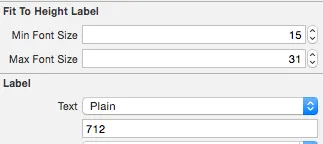
代码如下:
//
// TIFFitToHeightLabel.swift
//
import Foundation
import UIKit
@IBDesignable class TIFFitToHeightLabel: UILabel {
@IBInspectable var minFontSize:CGFloat = 12 {
didSet {
font = fontToFitHeight()
}
}
@IBInspectable var maxFontSize:CGFloat = 30 {
didSet {
font = fontToFitHeight()
}
}
override func layoutSubviews() {
super.layoutSubviews()
font = fontToFitHeight()
}
// Returns an UIFont that fits the new label's height.
private func fontToFitHeight() -> UIFont {
var minFontSize: CGFloat = self.minFontSize
var maxFontSize: CGFloat = self.maxFontSize
var fontSizeAverage: CGFloat = 0
var textAndLabelHeightDiff: CGFloat = 0
while (minFontSize <= maxFontSize) {
fontSizeAverage = minFontSize + (maxFontSize - minFontSize) / 2
if let labelText: NSString = text {
let labelHeight = frame.size.height
let testStringHeight = labelText.sizeWithAttributes(
[NSFontAttributeName: font.fontWithSize(fontSizeAverage)]
).height
textAndLabelHeightDiff = labelHeight - testStringHeight
if (fontSizeAverage == minFontSize || fontSizeAverage == maxFontSize) {
if (textAndLabelHeightDiff < 0) {
return font.fontWithSize(fontSizeAverage - 1)
}
return font.fontWithSize(fontSizeAverage)
}
if (textAndLabelHeightDiff < 0) {
maxFontSize = fontSizeAverage - 1
} else if (textAndLabelHeightDiff > 0) {
minFontSize = fontSizeAverage + 1
} else {
return font.fontWithSize(fontSizeAverage)
}
}
}
return font.fontWithSize(fontSizeAverage)
}
}
这部分内容大量借鉴了Joel Fischer的答案。他的答案仅考虑标签的高度 - 我进行了一些更改,同时考虑了标签的宽度(给定输入字符串),这正是我想要的:
typedef enum
{
kDimensionHeight,
kDimensionWidth,
} DimensionType;
@implementation UIFont (AdaptiveFont)
+ (UIFont *)_adaptiveFontWithName:(NSString *)fontName minSize:(NSInteger)minSize labelDimension:(CGFloat)labelDimension testString:(NSString *)testString dimension:(DimensionType)dimension
{
UIFont *tempFont = nil;
NSInteger tempMin = minSize;
NSInteger tempMax = 256;
NSInteger mid = 0;
NSInteger difference = 0;
CGFloat testStringDimension = 0.0;
while (tempMin <= tempMax) {
@autoreleasepool {
mid = tempMin + (tempMax - tempMin) / 2;
tempFont = [UIFont fontWithName:fontName size:mid];
// determine dimension to test
if (dimension == kDimensionHeight) {
testStringDimension = [testString sizeWithFont:tempFont].height;
} else {
testStringDimension = [testString sizeWithFont:tempFont].width;
}
difference = labelDimension - testStringDimension;
if (mid == tempMin || mid == tempMax) {
if (difference < 0) {
return [UIFont fontWithName:fontName size:(mid - 1)];
}
return [UIFont fontWithName:fontName size:mid];
}
if (difference < 0) {
tempMax = mid - 1;
} else if (difference > 0) {
tempMin = mid + 1;
} else {
return [UIFont fontWithName:fontName size:mid];
}
}
}
return [UIFont fontWithName:fontName size:mid];
}
+ (UIFont *)adaptiveFontWithName:(NSString *)fontName minSize:(NSInteger)minSize labelSize:(CGSize)labelSize string:(NSString *)string
{
UIFont *adaptiveFont = nil;
NSString *testString = nil;
// get font, given a max height
testString = @"abcdefghijklmnopqrstuvwxyzABCDEFGHIJKLMNOPQRSTUVWXYZ";
UIFont *fontConstrainingHeight = [UIFont _adaptiveFontWithName:fontName minSize:minSize labelDimension:labelSize.height testString:testString dimension:kDimensionHeight];
CGSize boundsConstrainingHeight = [string sizeWithFont:fontConstrainingHeight];
CGSize boundsConstrainingWidth = CGSizeZero;
// if WIDTH is fine (while constraining HEIGHT), return that font
if (boundsConstrainingHeight.width <= labelSize.width) {
adaptiveFont = fontConstrainingHeight;
} else {
// get font, given a max width
// i.e., fontConstrainingWidth
testString = string;
adaptiveFont = [UIFont _adaptiveFontWithName:fontName minSize:minSize labelDimension:labelSize.width testString:testString dimension:kDimensionWidth];
// TEST comparison
boundsConstrainingWidth = [string sizeWithFont:adaptiveFont];
}
return adaptiveFont;
}